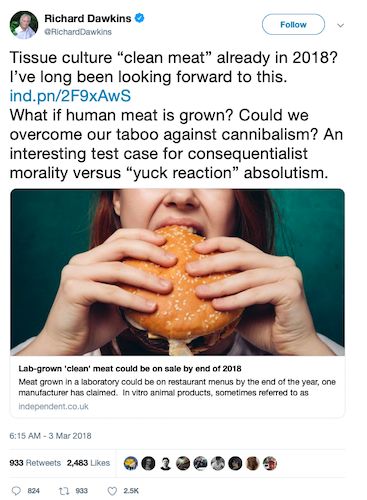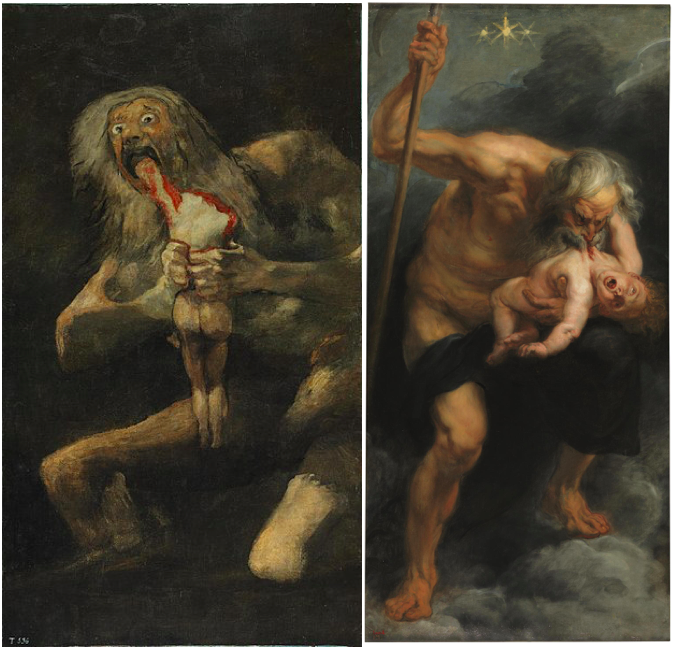On Eating People
 Thursday, October 10, 2019 at 03:17AM
Thursday, October 10, 2019 at 03:17AM Preface: I was driving up the coast the other day and got to thinking about the whole baby eating controversy that’s been making headlines and memes lately, and I began jotting down some of the things I recalled about cannibalism. To my surprise, I conjured up numerous thoughts on the subject, and soon had a few pages of my notepad filled up.
Note to readers: This entry explores grisly details of a touchy and often morbid subject matter which I attempt portray in a matter-of-fact manner so as to avoid being gratuitous. My intent was to write and informative article, not to be macabre.
To me then it seems most likely that the horror of incest is learned from our culture, and is not part of our biological inheritance. This is even more obviously true of that other deep horror of ours – cannibalism. The fact that the incest taboo is very general, even if not quite universal, is used as an argument that it must have some innate basis. But no one could possibly argue that the man-eating taboo was universal and hence deeply instinctive. There are too many well-documented accounts of cultures in which the eating of human flesh has been openly sanctioned as a regular or an occasional practice. Yet the taboo is strong enough so that most of us, I suspect, would die of starvation before we would eat each other. There are, of course, well-authenticated cases of cannibalism among Westerners at the point of starvation, but surely the cases of Westerners dying of starvation without resorting to cannibalism are more numerous.
-Marston Bates, Gluttons and Libertines, VI: Incest and Cannibalism
The subject of people eating people has been in the news quite a bit recently. The latest murmurings of the cannibalism question seem to stem from Magnus Söderlund, a professor at the Stockholm School of Economics, who last month, at a food and beverage industry trade show called ‘GastroSummit,’ allegedly floated the notion that eating dead humans should be considered as one of various metods (along with eating insects and pets) of combating impending food scarcity and climate change (I say allegedly because I cannot find any video footage of his presentation, only articles about it and a Swedish television news program interview in which professor Söderlundis speaking like the Swedish chef from Jim Henson’s Muppet Show).
As with President Obama’s former science and technology advisor Professor John P. Holdren (aka “Obama’s Science Czar) – who throughout the 1970s appeared to advocate for forced sterilization and compulsory abortions in effort to counter overpopulation (see Ecoscience, a book he co-authored along with Paul and Anne Elrich) – Professor Söderlund is likely motivated by a genuine concern for how humans can live sustainability on Earth. Perhaps he’s right in proposing that we must overcome our taboo against cannibalism and that it’s time to jumpstart the “human flesh industry.” Having said that, it would be wise to err on the side of caution in the event that his premise or conclusion is flawed. That is to say: we shouldn’t start eating the dead until we know and agree that it’s the right thing to do. (Tangentially, the two most head-scratching product websites I’ve visited are Transkids, which only recently removed their prosthetic penises and “stand-to-pee” devices for preteens ranging in ages 8 to 13 years-old – a similar age range sexualized at Drag Queen Storytime events, which are probably not as controversial as Drag Syndrome [but possibly as problematic as Ms. Monopoly] – and the Human Leather Company, which apparently had to close their order book due to popular demand, and may not be alone in selling clothing products made from human skin in the traditions of anthropodermia as practiced by some American slaveholders who evidently made shoes the skin of their slaves and a few German Nazis who may have made lampshades from the skin of concentration camp inmates and soap from the fat of human corpses.)
Professor Söderlund’s propositions would have faded away if it were not for the trolling of Congresswoman Alexandria Ocasio-Cortez by a woman who references his idea in a stunt at a town hall in which the woman stated, “A Swedish Professor said we can eat dead people, but it’s not fast enough. So I think your next campaign slogan needs to be this: “We’ve got to start eating babies… Even if we were to bomb Russia, we still have too many people, too much pollution, so we have to get rid of the babies. That’s a big problem. Just stopping having babies is not enough. We need to eat the babies.” Equally comical to the AOC is the behavior of Principal Skinner in The Simpsons Halloween show story Nightmare Cafeteria, which was part of their Treehouse of Horror V episode, where the subject of cannibalism was also breached.
Professor Söderlund isn’t alone in the scientific world in his call to consider consuming human meat. In a tweet last year evolutionary biologist Richard Dawkins suggested that producing and lab-grown “clean meat” (cultured tissue grown from animal stem cells in-vitro) could be derived from human cells, and thus by eating synthetic human meat society might overcome its aversion to cannibalism. I suspect that before trying to cultivate human meat, the clean meat companies will first perfect their chicken and beef products, as Aleph Farms has recently done in outer space.

Humans eating humans is nothing new, but robots eating humans is. Back in 2009 a DARPA-backed project to develop an autonomous robot that could be powered by collecting and combusting vegetation. Naturally, the idea surfaced that the Energetically Autonomous Tactical Robot, or EATR – the schematic of which featured a chainsaw attached to the arm of the robot – could feed off of the corpses of soldiers in battlefields, even though this apparently was not the original intention. In his 1958 book Gluttons and Libertines, zoologist Marston Bates makes the point that eating the corpses of fallen soldiers is distasteful but certainly not as bad as killing them in the first place: Some people only eat corpses, individuals that have been slain in battle or that have died from some other cause. As in the case of the Donner Party, this seems reasonable enough in the abstract. Maybe we could alleviate the meat shortages of wartime by adding the corpses of soldiers killed in battle to the meat supply? Horrible? Surely it is not as bad to eat someone already dead as it is to kill him in the first place. Indeed, this business of eating dead bodies is surely no worse than reported instances of necrophilia-mutilation in Mexico where female assassins working for drug cartels drink and bathe in the blood of their decapitated murder victims before having sex with them. How do the ethics of cannibalization stack up against organ harvesting or the trade in body parts? Beyond this, I think a loose argument could be made that it’s more moral to eat a human who has died of natural causes than to kill an animal for its meat – but I wouldn’t want to be the one making that argument nor do I agree with it. Cannibalism aside, humans still have a long way to go in our effort to humanely treat the massive number of animals we slaughter, consume, and share the planet with. (Where this Philadelphia Eagles fan’s devouring of horseshit lies along the morality spectrum is unclear.)
As Bates makes clear, there’s plenty of evidence of cannibalism throughout history and across the globe among humans and other species of the Homogenus (Cannibalism in other animal species is also well documented).
There is evidence of the ancientness of cannibalism in the paleontological record. In the case of the fossils of Pekin man, many of the long bones were split open, and the only likely explanation of this is that they were split by other men to get at the marrow. Man has long been particularly fond of marrow, which he gets by splitting bones; any other animal would have to chew them. Each of the Pekin skulls also had a hole in its base – the foramen magnum, which is the weakest part of the skull, had been cut out to get at the brains. Contemporary head-hunters often make a similar break to get at the brains of their victims, which are ceremonially eaten. A number of Neanderthal skulls have been found with this same kind of opening in the foramen magnum…
Pekin man and his fellow Homo erectus existed in the Pleistocene epoch roughly between 1.9 million and 500,000 years ago depending on who you ask. Archeologists believe that they have found evidence of anthropophagy amongst the homo sapiens who lived on Iberian Peninsula 10,000 years ago. In modern history, cannibalism has been practiced by indigenous peoples in the Caribbean and in Papua New Guinea. Bates writes:
In some parts of the world, but especially on many Pacific islands, man is simply the easiest available source of meat – and native reports also indicate that human flesh is tasty. Some peoples, like the pre-Colombian Carbis of America, waged war for the purpose of taking captives to be killed and eaten at some later time. In some cultures only friends are eaten; this, by analogy with in-marriage, or endogamy, is called “endocannbialism.” In other cultures only enemies are eaten (“exocannibalism”). Ronald Berndt, in a recently published book, Excess and Restraint, has given a detailed account of cannibal practice among a group of New Guinea mountain people, where government and missions have only recently succeeded in suppressing the custom – or at least driving it underground. These people were quite blithe about eating human flesh, regarding it simply as a readily available source of meat, otherwise hard to come by expect for their few pigs – there are no large native mammals in New Guinea.
Perhaps the most renown story of cannibalism in Greek mythology is that of the Titan Kronos devouring his children out of fear of a prophecy that one would grow up and dethrone him. Zeus, who was born in secret, eventually did this after forcing his father to vomit out the other children and launching an epic war against the Titans. Spanish painter Francisco de Goya and Flemish painter Peter Paul Rubens have portrayed the subject of Saturn Devouring His Son in frightening yet remarkable pieces of art which are housed at the Pardo Museum in Madrid.
 Paintings by Francisco de Goya and Flemish Peter Paul Rubens
Paintings by Francisco de Goya and Flemish Peter Paul Rubens
As in the case of the sixteen survivors of Uruguayan Air Force Flight 571, which crashed on a glacier in the Andes in October 1972, people may resort to cannibalism out of sheer desperation. In these prolonged emergencies human values and principles are pushed to the brink and repeatedly smashed against the wall of reality to determine how strong their convictions actually are. Though we would like to think that we would starve to death before eating the flesh of the dead, men and women who have been put in this predicament have understandably buckled, sacrificed their dignity, and opted for violating a principle that they once thought sacrosanct. I believe, for those of us who were raised with the conviction that eating people is wrong no matter the severity of your hunger, that a strong indication of one’s humanity can be ascertained if an individual maintains their vow against practicing, ordaining, or condoning cannibalism when afflicted by malnourishment during the worst of times. There is perhaps no greater example of how this conviction was honorably upheld than during Hannibal’s crossing of the Alps during the Second Punic War in 218 B.C. The Carthaginian general Hannibal led an invasion force of over 60,000 men (not to mention hundreds of pack animals and around 40 war elephants) through the Alps during the onset of winter in the war against Rome. Half of his men died during the crossing. According to the Greek historian Polybius, Hannibal’s lieutenant urged the general to permit the cannibalization of the fallen soldiers that lay dead in the snow so that the surviving army may be nourished, and Hannibal said no. Juxtapose the virtue of Hannibal in this living hell to Dante’s account of the Couto Ugolino of Pisa losing his mind in the fictional hell that is The Divine Comedy: Inferno. In Canto XXXIII, in the sixth circle of Lower Hell, Dante approaches the count who is gnawing on the brain of an archbishop, and recounts how, when he was imprisoned for betraying the city, his sons were also locked up and they begged the hungry count to eat them so as to alleviate their suffering. Ugolino tells Dante, “I bit my hands in anguish. And my children, who thought that hunger made me bite my hands, were quick to draw up closer to me, saying: ‘O father, you would feed on us: you were the one who gave us this sad flesh; you take it from us!’”

Ugolino and His Sons, sculpture by Jean-Baptiste Carpeaux, Metropolitan Museum of Art
Like Hannibal, the protagonists in Cormac McCarthy’s post-apocalyptic novel The Road come down on the side against cannibalism. In The Road, McCarthy writes “all the store of food had given out and murder was everywhere upon the land. The world soon to be largely populated by men who would eat your children in front of your eyes and the cities themselves held by cores of blackened looters who tunneled among the ruins and crawled from the rubble white of tooth and eye carrying charred and anonymous tins of food in nylon nets like shoppers in the commissaries of hell.” Toward the end there’s an exchange between a boy and a man:
“Do you have a little boy?”
“We have a little boy and we have a little girl.”
“And you didn’t eat them?”
“No.”
“You don’t eat people?”
“No. We don’t eat people.”
Halloween is upon us, and in a matter of weeks people will be dressing up in costumes meant to invoke fear in others. We fear ghosts and monsters and the living dead. We fear the unknown and the unfamiliar, such as trekking solitaire under the stars across alien hinterlands, diving alone along a remote coast, or seeing creatures in the wild that we are more accustomed to seeing behind cages, in tanks, or on a television or computer screen. But these are the things we should not fear, for they ultimately do us little harm. In the 21st century the most monstrous things that happen to us are the things we do to each other. Our species is by far the scariest creature to have ever walked the Earth, and if we are to fear anything then we should fear the times when human morality drifts far afield, when insane behavior is made normal or institutionalized, and how we will act in the nightmare times of hell on Earth that happen every so often but that most of us are lucky enough to have never experienced and can hardly imagine living through.
 Aaron |
Aaron |  Post a Comment |
Post a Comment | 
Reader Comments